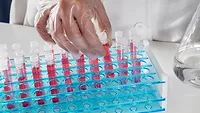USDA-FSIS Publishes FY 2024 PHRs and Thresholds
.webp?t=1661887788)
Credit: U.S. Department of Agriculture Food Safety and Inspection Service
The U.S. Department of Agriculture’s Food Safety and Inspection Service (USDA’s FSIS) recently posted its fiscal year (FY) 2024 Public Health Regulations (PHR) report. The report covers how FSIS determines PHRs and their thresholds. The FY 2024 PHRs and their thresholds will go into effect October 2023.
Public Health Regulations (PHRs) are verified regulations with statistically higher individual noncompliance rates in establishments in the three months prior to a microbiological positive or a public health-related enforcement action than in establishments with no positives or enforcement actions. This statistical association does not inherently imply that a particular regulation constitutes a more serious food safety concern, rather, it provides a statistical association to help FSIS better align scheduling criteria and agency resources. PHRs are not the only important food safety and public health related regulations, as noncompliance with other regulations remain critical indicators of public health concern but may not be statistically associated with PHR criteria.
FSIS updates its PHRs annually, and uses decision criteria described in FSIS Directive 5100.4 to prioritize establishments for Public Health Risk Evaluations (PHREs), including PHR noncompliance. FSIS has analyzed the most recent data to develop the FY 2024 PHR list, including the thresholds used to prioritize establishments for PHREs and to alert inspection personnel of elevated PHR noncompliance levels.
The PHR list for FY 2024 is as follows, the complete regulation descriptions for which can be read in the 2021 Code of Federal Regulations:
- 310.18(a): Carcasses, organs, and other parts handled in a sanitary manner
- 310.18(c): Written procedures to prevent contamination; all swine slaughter
- 310.18(c)(2)(iii): Records of test results for sampling program
- 310.18(d): Daily records sufficient to document the implementation and monitoring of contamination control procedures
- 310.22(c): Disposal of specified risk material (SRM)
- 310.22(e)(1): Written procedures for removal, segregation, and disposition of SRMs
- 310.22(e)(2): Appropriate corrective actions
- 310.22(e)(3): Evaluate effectiveness of procedures for removal, segregation, and disposition of SRMs
- 310.22(f)(2): Use of routine operational sanitation procedures on equipment used to cut through SRMs
- 310.3: Carcasses and parts in certain instances to be retained.
- 318.2(a): All products subject to reinspection by program employees
- 318.2(d): Removal of U.S. retained by authorized program employees only
- 381.65(a): Clean and sanitary practices; products not adulterated
- 381.65(f): Procedures for controlling visible fecal contamination
- 381.65(g): Procedures for controlling contamination throughout the slaughter and dressing operation
- 381.65(h): Recordkeeping requirements
- 381.71(a): Condemnation on ante mortem inspection
- 381.76(a): Post-mortem inspection, when required, extent
- 381.76(b)(6)(ii)(A): New Poultry Inspection System (NPIS) Sorting, Trimming, and Reprocessing
- 381.76(b)(6)(ii)(B): NPIS reprocessing and salvage
- 381.76(b)(6)(ii)(D): Ready-to-Cook verification in NPIS
- 381.91(a): Certain contaminated carcasses to be condemned
- 381.91(b): Reprocessing of carcasses accidentally contaminated with digestive tract contents.
- 416.1: Operate in a manner to prevent insanitary conditions
- 416.12(c): Plan identifies procedures for pre-op
- 416.13(a): Conduct pre-op procedures
- 416.13(b): Conduct other procedures listed in the plan
- 416.13(c): Plant monitors implementation of sanitation standard operating procedures (SSOPs)
- 416.14: Evaluate effectiveness of SSOPs and maintain plan
- 416.15(a): Appropriate corrective actions
- 416.15(b): Procedures for corrective action
- 416.16(a): Daily records required, responsible individual, initialed and dated
- 416.2(a): Grounds and Pest Control
- 416.2(b)(1): Sound construction, good repair and sufficient size
- 416.2(b)(2): Walls/floors/ceilings durable, impervious, cleaned and sanitized
- 416.2(b)(4): Inedible from edible separated by time or space
- 416.3(b): Constructed, located and operated in a manner that does not deter inspection
- 416.3(c): Receptacles for storing inedible material must identify permitted use
- 416.4(a): Food contact surface, cleaning and sanitizing as frequency
- 416.4(d): Product processing, handling, storage, loading, unloading, and during transportation must be protected
- 416.6: Only FSIS program employee may remove "U.S. Rejected" tag
- 417.2(a)(1): Hazard analysis
- 417.2(c): Contents of Hazards Analysis and Critical Control Points (HACCP) Plan
- 417.2(c)(4): List of procedures and frequency
- 417.3(a)(1): Identify and eliminate the cause
- 417.3(a)(2): CCP is under control
- 417.3(a)(3): Establish measures to prevent recurrence
- 417.3(a)(4): No adulterated product enters commerce.
- 417.3(b)(3): No adulterated product enters commerce.
- 417.3(b)(4): Reassessment
- 417.3(c): Document corrective actions
- 417.4(a): Adequacy of HACCP in controlling food safety hazards
- 417.4(a)(1): Initial validation
- 417.4(b): Reassessment of hazard analysis
- 417.5(a)(1): Written hazard analysis
- 417.5(a)(2): Written HACCP plan
- 417.5(a)(3): Records documentation and monitoring of CCP's and critical limits
- 418.2: Notification of adulterated or misbranded product in commerce
- 430.4(a): Listeria monocytogenes, post-lethality exposed ready-to-eat (RTE)
- 430.4(b)(3): Alternative 3
- 430.4(c)(2): Listeria monocytogenes, documentation that supports decision in hazard analysis
- 430.4(c)(3): Listeria monocytogenes, maintain sanitation in post-lethality processing environment
- 430.4(c)(5): Listeria monocytogenes, evaluate control measures in SSOP.
Compliance by establishments with these regulations will be evaluated and compared to cut points that have been set for two broad categories of establishment operations: Slaughter, and Combination (Processing plus Slaughter). The cut points are, for processing 2.49–3.76 percent, and for combination, 4.44–7.17 percent. The higher end of the range is the threshold at which FSIS will consider the establishment for a PHRE. The lower end of the range is the threshold at which FSIS inspection personnel will be notified via a PHIS Early Warning Alert that an establishment is at an elevated level.
Looking for quick answers on food safety topics?
Try Ask FSM, our new smart AI search tool.
Ask FSM →






.webp?t=1721343192)
